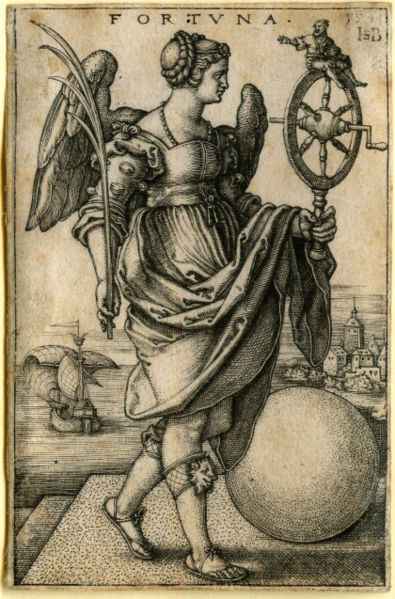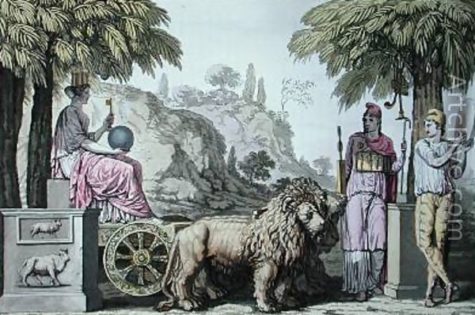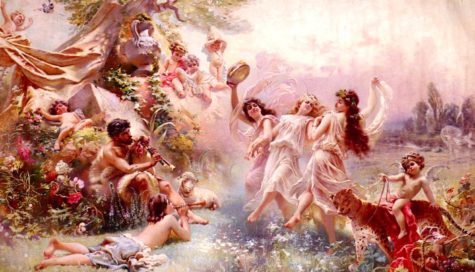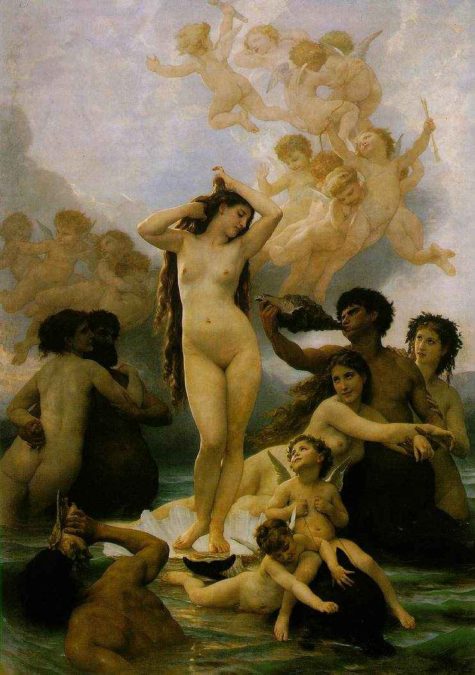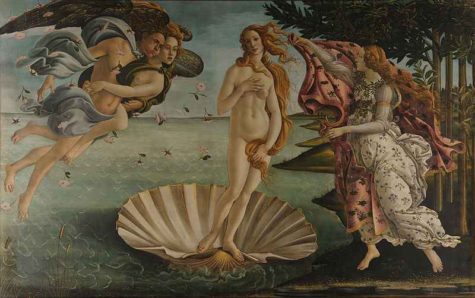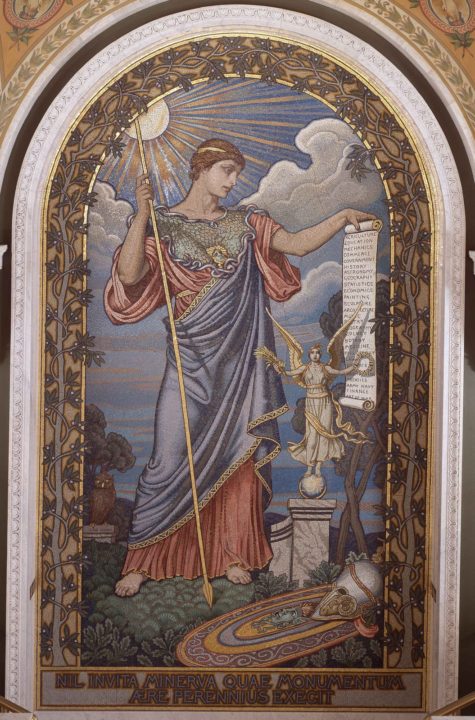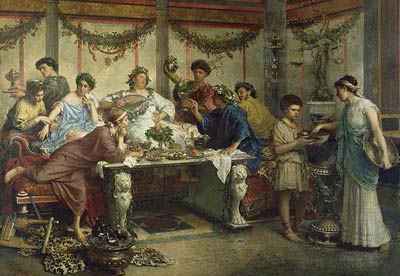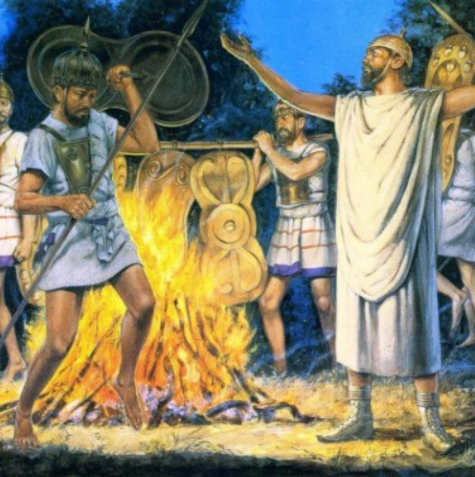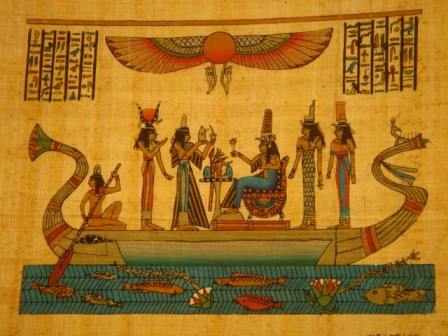Roman Festivals
April 5th. When the next Dawn shall have shone in the sky, and the stars have vanished, and the Moon shall have unyoked her snow white steeds, he who shall say, “On this day of old the temple of Public Fortune was dedicated on the hill of Quirinus”, will tell the truth.
~Ovid
April 5 is Lady Luck Day. As you can see from the above quote, it is dedicated to Fortuna, the Roman goddess of good fortune, and marks the day that her temple of Public Fortune was dedicated in Ancient Rome on the hill of Quirinus.
- Themes: Luck; Wealth; Abundance; Destiny; Success
- Symbols: Wheel; Cornucopia
About Fortuna:
Fortuna, whose name means ‘she who brings’, is the keeper of our destiny and the guiding power behind all fortunate events. She stands on top of Fortune’s wheel, steering us toward success and victory all year long.
To Do Today:
Who of us couldn’t us a little of Fortuna’s assistance with tax day on the horizon? For a little extra cash, dab your automobile, bike, or motorcycle wheels with almond oil or pineapple juice. Symbolically this invokes Fortuna’s help by keeping money “rolling” in! Also dab your steering wheel similarly – this way you can keep a “handle” on personal finances.
Romans traditionally asked Fortuna about their fate and difficult problems today, then received replies on slips of paper, often baked into small bread balls akin to a fortune cookie! This is fun for a gathering of people to try. Each person should write a word or short phrase on a piece of paper (all of which are equal in size). These get dropped into a bowl, and at the end of the day everyone can reach in to see what Fortuna has to say.
Wear colors that indicate to Fortuna what you need most (green for prosperity and luck, blue for victory, red for success, yellow for communication and creativity, and purple for spirituality and leadership qualities). Or, don lucky clothing and carry your lucky charms. Fortuna’s energy is already housed within them.
Found in: 365 Goddess
The Megalisia was a Phrygian festival in honor of Cybele, the Magna Mater. This was a festival with games celebrated at Rome in the month of April and in honor of the great mother of the gods. Following the advice of the Sibylline oracle on how to end the Punic wars, the meteorite which represented Cybele was brought from Phrygia to Rome in 204 BCE where it was installed in the Temple of victory on April 4th. The day of its arrival was solemnized with a magnificent procession, lectisternia, and games, and great numbers of people carried presents to the goddess at the Capitol.
The following harvest was great and the war ended the next year.
The regular celebration of the Megalesia, however, did not begin until about a dozen years later, when the temple which had been vowed and ordered to be built in 203 B.C., was completed and dedicated by M. Iunius Brutus.
The Romans began the celebrations with a parade, in which an image of the Goddess, Cybele, was carried through the streets in a chariot drawn by lions, her animals. The castrated priests who served her danced alongside, playing timbrels and cymbals and gashing themselves. Lucretius says “with bronze and silver they strew all the paths of her journey … and snow rose-blossoms over her.”Rome, commemorating the arrival of the goddess to her Roman Temple.”
The festival lasted for six days, beginning on the 4th of April. The season of this festival, like that of the whole month in which it took place, was full of general rejoicings and feasting. It was customary for the wealthy Romans on this occasion to invite one another mutually to their repasts, and the extravagant habits and the good living during these festive days were probably carried to a very high degree. For that reason, a senatusconsultum was issued in 161 B. C., prescribing that no one should go beyond a certain extent of expenditure.
The games which were held at the Megalesia were purely scenic, and not circenses. They were at first held on the Palatine in front of the temple of the goddess, but afterwards also in the theaters.
The first ludi scenici at Rome were, according to Valerius Antias, introduced at the Megalesia, either in 193 or 191 b.c. The day which was especially set apart for the performance of scenic plays was the third of the festival.
Slaves were not permitted to be present at the games, and the magistrates appeared dressed in a purple toga and praetexta, whence the proverb, purpura Megalensis. The games were under the superintendence of the Curule Aediles, and we know that four of the extant plays of Terence were performed at the Megalesia. Cicero, probably contrasting the games of the Megalesia with the more rude and barbarous games and exhibitions of the circus, calls them maxime casti, solemnes, religiosi.
Source: Nova Roma and Smith, Dictionary of Greek and Roman Antiquities
Note:
The book, 365 Goddess, describes this festival as a Roman Festival celebrating the accuracy of the Sibylline oracles, who predicted the way for the Roman victory in the Punic Wars. Her suggestions for celebrating this ancient festival is as follows:
- Themes: Divination, Protection, Victory, Children, Birth, Communication.
- Symbols: The written word, Divination tools, Fertility symbols.
- Rulers: The Carmenae.
The Carmenae is a group of goddesses who correspond to the Muses of Greek tradition; they know our past, see what’s in store in the future, foretell children’s fates, and teach us the effective use of “letters” (the alphabet), the arts, and how to tell fortunes. They also oversee midwives.
Romans traditionally honored the goddesses today with music and song, so put on some magical tunes! The Carmenae will saturate the music and uplift your spirit.
Ask the Carmenae to help you write personalized invocations or spells today. Put pen to pad and let these goddesses inspire sacred words suited to your path and needs. Keep these in a magick journal for future use.
The Roman oracles often drew lots to determine a querent’s answer. If you have a question weighing heavily on your heart today, follow this custom and take out some variegated beans. Hold them. Concentrate on the question, then pick out one bean. A black one means “no”; white means “yes.” Red means that anger is driving action, brown means things are muddled, and green indicates growth potential. If you don’t have the beans, colored buttons or beads are a suitable alternative.
The Veneralia (April 1) was the Ancient Roman festival of Venus Verticordia (“Changer of hearts”), the goddess of love and beauty. The worship of the goddess Fortuna Virilis (“Bold fortune”) was also part of this festival.
In Rome, jewelry was ritually removed from the statue of the goddess, her image was then taken from her temple to the men’s baths, where it was undressed and washed in warm water by her female attendants, then garlanded with myrtle.
Similarly, women bathed themselves in the public baths wearing wreaths of flowers and myrtle on their heads. It was generally a day for women to seek divine help in their relations with men. Men also asked Venus Verticordia for her help in affairs of the heart, sex, betrothal and marriage.
Here’s a nice ritual for the Day of Venus:
- Color: Sea green, golden, and pink
- Element: Water
- Altar: Upon cloth of sea green, golden and pink, set many shells, flowers, beautiful ornaments, pink candles, hearts, doves, incense of rose and violets, and a great chalice of white wine.
- Offerings: Hearts and flowers. Giving a gift of love to someone.
- Daily Meal: Seafood. Angel hair pasta. Sweet breads, cakes, and desserts.
Invocation to Venus
Hail, Lady of the Morning Star!
You who rose form the sea foam,
Born of the impersonal severed phallus of the sky
Immersed in the impersonal womb of the sea,
You who rode to shore on a shell of pearl
And whose powers no one can resist
Save the virgin goddesses,
You who bring the glow of gold
Into the lives of all whom you touch,
Lady, we revere you as the avatar
Of the love between equals
Who look each other in the eye,
The attraction and pursuit
Between every particle in the universe.
Hail, Lady of the Evening Star!
You who rule the night
With its darker passions,
You who tempt the wistful heart,
You whose hands reach out
To all the world and more,
Lady, we revere you as a force of nature
Far greater than merely the human heart,
For you are the force that binds together
All that dances with another of its kind
In the endless dance of creation.
(The wine is passed around, and poured as a libation to Venus. Each takes a flower and wears it in honor of Venus.)
Chant:
Venus Veritas
Amor Amor
Source: Wikipedia and Pagan Book of Hours
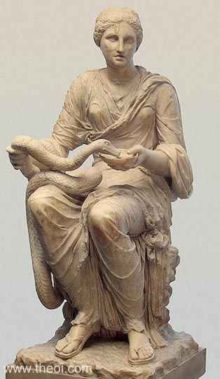 March 30 is the Festival of Salus, the Roman goddess of public safety, health and welfare.
March 30 is the Festival of Salus, the Roman goddess of public safety, health and welfare.
Salus was a minor goddess, the daughter of Aesculapius, the god of healing, whose staff, with a snake coiled round it, is symbolic of the practice of medicine. Their Greek equivalents were Aklepios and Hygeia. Her role in the pantheon was to feed and care for her father’s sacred snakes and act as his assistant. She was worshiped as being responsible for the welfare, not just of individuals, but of the people as a whole. Her name in Greek and Roman comes down to us in such words as ‘hygiene,’ ‘salve’ and ‘salubrious,’ and even ‘salute’ and ‘safe.’
In works of art, of which a considerable number has come down to our time, she was represented as a virgin dressed in a long robe, with the expression of mildness and kindness, and either alone or grouped with her father and sisters, and either sitting or standing, and leaning on her father. Her ordinary attribute is a serpent, which she is feeding from a cup.
To invoke the healing power of Salus (Hygeia) either of these two invocations can be used, or you can create an invocation of your own.
“O much desired, prolific, general queen. Hear me, life-bearing Hygeia, of beauteous mien, mother of all; by thee diseases dire, of bliss destructive, from our life retire; and every house is flourishing and fair, if with rejoicing aspect thou art there. Each daidal art thy vigorous force inspires, and all the world thy helping hand desires. Hades, life’s bane, alone resists thy will, and ever hates thy all-preserving skill. O fertile queen, from thee for ever flows to mortal life from agony repose; and men without thy all-sustaining ease find nothing useful, nothing formed to please. Without thy aid, not Hades’ self can thrive, nor man to much afflicted age arrive; for thou alone, of countenance serene, dost govern all things, universal queen. Assist thy mystics with propitious mind, and far avert disease of every kind.”
~ Orphic Hymn 68
“Hygeia, most revered of the blessed ones among mortals, may I dwell with you for what is left of my life, and may you graciously keep company with me: for any joy in wealth or in children or in a king’s godlike rule over men or in the desires which we hunt with the hidden nets of Aphrodite, any other delight or respite from toils that has been revealed by the gods to men, with you, blessed Hygeia, it flourishes and shines in the converse of the Kharites; and without you no man is happy.”
~from the Ariphron
Dies Sanguinis (Day of Blood) was a festival held in Ancient Rome on 24 March. Also known as Bellona’s Day, this was an occasion when the Roman votaries of the war-goddess Bellona cut themselves and drank this sacrificial blood to propitiate the deity.
The worship of this asiatic goddess was introduced into Rome apparently by Sulla, to whom she had appeared, urging him to march to Rome and bathe in the blood of his enemies.
Note: She should not be mistaken for the Roman Bellona, whose festival, which was largely a huge feast, took place on the 3rd of June.
For her a new temple was built, and a college of priests (Bellonarii) instituted to conduct her fanatical rites, the prominent feature of which was to lacerate themselves and sprinkle the blood on the spectators. To make the scene more grim they wore black dresses (Tertullian, De Pallio) from head to foot.
The Priests of Bellona (also known as Bellonarii) practiced other rituals on Dies Sanguinis, one rite being to mutilate their own limbs, such as their own arms and legs with a sharp knife or knives in order to collect their own blood to either drink, or offer to their goddess Bellona in order to get her to invoke her war fury on them. In some instances, they would even drink their own blood in hopes that Bellona would grant a warlike frenzy.
An ancient source about Dies Sanguinis is in a book called “Apologeticum” by an early Roman Christian who states:
“on the sixteenth before the Kalends of April, that most sacred high priest of hers was offering, a week after, impure libations of blood drawn from his own arms…”
There also a plant known as the Bellonaria plant (solanum). Which is a corruption on the name Belladonna, a deadly nightshade, was used by priests at this festival, Dies Sanguinis.
When a priest ate its seeds, they would start to hallucinate. Those hallucinations were used by them to make prophetic and oracular statements in the name of their goddess.
Collected from various sources.
March 23 is the fifth day of the Quinquatria. A five day Roman festival to honor Minerva which coincides with the five day Ancient Greek festival to honor Athena – her Greek counterpart. Here is a ritual designed for group participation. It can, however, be modified for the solitary practitioner.
- Colors: Blue and brown
- Elements: Air and earth
- Altar: Upon a brown cloth light five blue candles, incense, and many tools of the crafter.
- Offerings: Make something.
- Daily Meal: Let those whose craft is cooking or baking make what they will as an offering.
Quinquatria Invocation III
Bones and clay of earth,
Flesh of trees and vines,
Thread from plant and animal,
Metal drawn from the ground
And forged in fire,
Our hands are midwives
To these unformed substances,
Given to us by the grace of the Mother,
As She gifts all her children.
We birth creations of beauty
That bring a smile to the eye,
We birth creations of usefulness
Made to be seized and worked day after day,
Fitting easily into the hand
That uses them unthinkingly.
Oh, ye many gods of the sacred touch,
Grant us the power to make manifest
With these our own humble hands.
(All approach the altar and select a tool, and speak their intentions towards it. Tools are then taken outside and laid on the Earth, and the Tool Blessing is said over them. Then, for the rest of the day, craftwork will be done, or things made or repaired.)
Tool Blessing (to be spoken or chanted or sung):
Father Labor, Mother Survival,
All brown gods of work and sweat;
Strong of arm, feet on Earth,
Bless this tool in Earth I set;
Sharp and keen, firm and fine,
Never break and never bend;
Be my strength, aid my skill,
Fill my hand and be my friend.
Found in: Pagan Book of Hours
In Ancient Roman religious tradition, The Hilaria (Greek: ἱλάρια; Latin: hilaris, “hilarious”) were festivals celebrated on the vernal equinox to honor Cybele, the mother of the Gods. The Romans took this feast originally from the Greeks, who called it ΑΝΑΒΑΣΙΣ, (Ascensus)
The day of its celebration was the first after the vernal equinox, or the first day of the year which was longer than the night (usually March 22) . The winter with its gloom had died, and the first day of a better season was spent in rejoicings.
The manner of its celebration during the time of the republic is unknown, except that Valerius Maximus mentions games in honor of the mother of the gods. Respecting its celebration at the time of the empire, we learn from Herodian that, among other things, there was a solemn procession, in which the statue of the goddess was carried, and before this statue were carried the most costly specimens of plate and works of art belonging either to wealthy Romans or to the emperors themselves.
All kinds of games and amusements were allowed on this day; masquerades were the most prominent among them, and everyone might, in his disguise, imitate whomsoever he liked, and even magistrates.
Here is a nice ritual to honor Cybele on her day from the Pagan Book of Hours:
- Color: Golden
- Element: Fire
- Altar: Upon a golden cloth set five gold candles, a chalice of wine, the figure of a lioness, and a crown resembling a turreted city.
- Offerings: Lions, herbs, wild game, music.
- Daily Meal: Game birds, such as turkey, goose, pheasant, or quail. Moretum – here’s recipe: Ancient Roman Garlic Pesto.
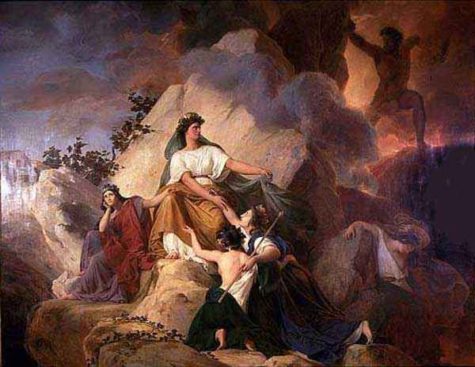
Invocation to Cybele
Magna Mater
Great Lady of the City
Protector of Civilization
Inspirer of music in the city streets
And in the high houses,
Queen upon your throne,
Guard the lands of stone and metal
Where the feet of thousands tread.
Magna Mater
Great Lady of the Wilderness
Protector of the Wild Things
Inspirer of music in lonely places
And in the deep metro’ons,
Lioness who hunts your prey,
Guard the beleaguered lands of untouched Nature
Where few feet tread
Save for the children of Earth whose steps belong there.
Magna Mater,
You who understand both worlds,
Do not let us forget
That both are valued in your eyes
That both hold promise and treasure
And that we must learn to live in both
If we are to survive.
(Beat drum and clash cymbals during chanting.)
Chant:
Magna Mater Cybele Cybele
Source: Wikipedia
In the Roman calendar, March was sacred to Mars. The “jumping priests,” or Salii began the Festival of the Salii on March 21 with a purification of the sacred trumpets that the Romans carried off to war. That date was originally the Roman New Year’s Day because it was the start of the growing and campaign season.
On March 21, the Salii marched to the Regia taking the bronze Ancilia, the sacred shield that had fallen down from heaven, and its 11 copies. They danced through the streets carrying poles with the shields mounted on them in their left hands. With their other hand, they banged the shields with a drumstick. Even in the time of Cicero, the Carmen Saliare they sang was so ancient that he could not understand it.
At the end of each night, they would stop at a place to be feasted before starting up again the next day. This festival would end on March 24 when they would return to the Regia and return the shields.
Found at Wikipedia
March 21 is the third day of the Quinquatria. A five day Roman festival to honor Minerva which coincides with the five day Ancient Greek festival to honor Athena – her Greek counterpart. Here is a ritual designed for group participation. It can, however, be modified for the solitary practitioner.
- Color: Blue
- Element: Air
- Altar: Upon a blue cloth lay many musical instruments, blue candles, a clear glass bowl of water, and a fan made from a bird’s wing.
- Offerings: Song and music.
- Daily Meal: Light vegetarian meal.
Quinquatria Invocation II
(to be sung)
Hail Athena, true and bright,
Sharp your blade and keen your sight,
Goddess of a Thousand Works,
Giver of the soul in flight.
Guide our touch as we reach out,
Weaver, crafter, artisan,
Guide our urge to build and make,
Guide the power of our hands.
Mentor, teacher, patient tutor,
Maker of heroes through the years
In the epic glance of history,
Giving sight to blinded seers,
Giving purpose to the wanderer,
Giving courage to the weak,
We beseech you, armored Lady,
By the Word of Power you speak,
Like the wind that blows so cold
And bright and clear through minds of grey,
Stand beside us when we falter,
Sweep our weakness clean away.
(The rest of the day should be spent in song, whatsoever has been chosen by the community as the absolute best that they can do, as an offering. Songs can be solo offerings, or as a group. Those who wish to give private offerings can play instrumental music after the main group has left.)
Found in: Pagan Book of Hours
The Festival of Navigation (March 5th) was an ancient Roman festival that celebrated Isis as the ruler over safe navigation, boats, fishing, and the final journey of life. At this festival, after an elaborate parade, a Ship of Isis filled with great offerings of incense, flowers, libations and small shrines was sent out to sea.
For an eyewitness description of this festival, visit this post: Navigium Isidis.
I do like the idea of sending out ships with offerings to Isis. And with that in mind, I’m sharing here a video tutorial on how to make a paper boat that floats on water. This small boat could be decorated with symbols or with petitions for guidance, filled small offerings, and then floated down a stream, creek, river, etc. If you don’t have access to water, you could ritually burn your boat on a bed of incense and fragrant herbs and allow the smoke to take your petitions and offerings to the goddess.
